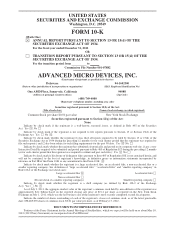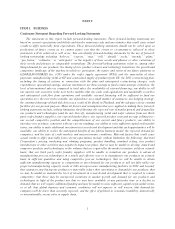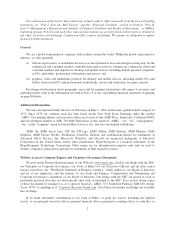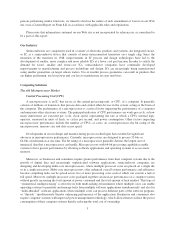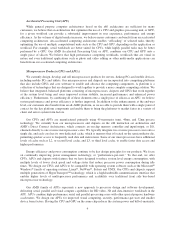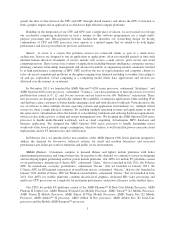AMD 2011 Annual Report Download - page 11
Download and view the complete annual report
Please find page 11 of the 2011 AMD annual report below. You can navigate through the pages in the report by either clicking on the pages listed below, or by using the keyword search tool below to find specific information within the annual report.speeds the flow of data between the CPU and GPU through shared memory and allows the GPU to function as
both a graphic engine and an application accelerator in high efficient compute platforms.
Building on the integration of our CPU and GPU onto a single piece of silicon, we are focused on evolving
our accelerated computing architecture in such a manner so that software programmers see a single multi-
purpose processing unit. Heterogeneous Systems Architecture describes our overarching design for having
combinations of CPU and GPU processor cores operate as a unified engine that we intend to be both higher
performance and lower power than our previous architectures.
Server. A server is a system that performs services for connected clients as part of a client-server
architecture. Servers are designed to run an application or applications, often for extended periods of time with
minimal human direction. Examples of servers include web servers, e-mail servers, print servers and cloud
computing servers. These servers run a variety of applications including business intelligence, enterprise resource
planning, customer relationship management and advanced scientific or engineering models commonly referred
to as high performance computing, or HPC. HPC involves the use of supercomputers and computer clusters to
solve advanced computational problems in disciplines ranging from financial modeling to weather forecasting to
oil and gas exploration. Cloud computing is a computing model where data, applications and services are
delivered over the internet or an intranet.
In November 2011, we launched the AMD Opteron™ 6200 series processor, codenamed “Interlagos,” and
AMD Opteron 4200 series processor, codenamed “Valencia,” our latest generation of microprocessors for server
platforms that consist of 8-, 12- and 16-core versions and are based on our x86 “Bulldozer” architecture. These
new processors are designed to specifically enhance the scalability of enterprise applications while enabling Web
and database center customers to better handle emerging cloud and virtualization workloads. Virtualization is the
use of software to allow multiple discrete operating systems and application environments (i.e., multiple virtual
servers) to share a single physical computer. By enabling multiple operating systems and applications to run on
the same server, virtualization offers the benefit of consolidating workloads and reducing hardware requirements,
which can also reduce power, cooling and system management costs. We designed the AMD Opteron 6200 series
processor to handle multi-threaded workloads, such as cloud computing, virtualization, HPC, databases and
business application. We designed the AMD Opteron 4200 series processor to handle demanding server
workloads at the lowest possible energy consumption, which we believe is well suited for power-conscious cloud
deployments and for IT infrastructure and collaboration.
In February 2011, we introduced five new members of the AMD Opteron 6100 Series platform designed to
address the demand for low-power, balanced systems for small and medium businesses and increased
performance-per-dollar-per-watt for enterprise and public sector environments.
Mobile Devices. Consumers continue to demand thinner and lighter mobile platforms with better
entertainment performance and longer battery life. In response to this demand, we continue to invest in designing
and developing higher performing and low power mobile platforms. Our APUs for mobile PC platforms consist
of our performance, mainstream A-Series APU, codenamed “Llano,” that we launched in July 2011, the E-Series
APU for mainstream, everyday performance, codenamed “Zacate,” that we launched in January 2011, the
C-Series APU for HD internet experiences in small form factors, codenamed “Ontario,” that we also launched in
January 2011 and the Z–Series APU for Windows-based tablets, codenamed “Desna,” that we launched in June
2011. Our APUs for mobile platforms combine discrete-level graphics, dedicated HD video processing and
multi-core CPU processors on a single die for maximum performance and power efficiency in the smallest space.
Our CPUs for mobile PC platforms consist of the AMD Phenom™ II Dual-Core Mobile Processor, AMD
Phenom II Triple-Core, AMD Phenom II Quad-Core Mobile Processor, AMD Turion™ X2 Mobile Processor,
AMD Turion II Mobile Processor, AMD Turion II Ultra Mobile Processor, AMD Turion Neo X2 Mobile
Processor, AMD Athlon™ II processor, AMD Athlon II Neo processor, AMD Athlon Neo X2 Dual-Core
processor and the Mobile AMD Sempron™ processor.
5



